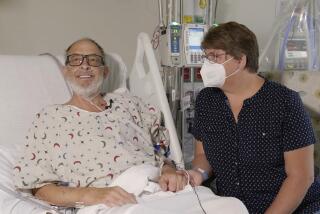Pig bladders help wounded humans regrow damaged muscle, scientists say
- Share via
They had each lost slabs of muscle to bomb blasts or other physical traumas, then struggled to regain even partial function of their mangled legs. Some even considered amputation.
After exhausting all conventional treatments, the five men volunteered for an experimental and seemingly outlandish surgical procedure aimed at spurring new muscle growth: They had swaths of chemically treated pig’s bladder sewn to their healthy muscle and left to decay.
In a paper published Wednesday in the journal Science Translational Medicine, researchers at the University of Pittsburgh say the implantation of so-called extracellular matrix into the patient’s legs prompted new muscle to grow by drawing the body’s own tissue-creating stem cells to the site.
As a result, three of the five patients saw at least a 20% increase in strength and a 25% improvement in functionality six months after the surgery, according to the report.
“Most of these patients have been through hell,” said Dr. Stephen Badylak, senior study author and professor of surgery at the University of Pittsburgh. “The things that you and I take for granted — getting out of a chair, taking steps, getting off a curb, getting out of the car — these are the types of deficits that these individuals had.”
Muscle makes up more than 40% of a person’s body mass, and, unlike other tissues, it has the ability to regenerate after injury. But that ability is lost when large volumes of muscle are torn away or deprived of blood flow. Instead, the body produces scar tissue.
Though scientists have proposed healing such injuries by injecting patients with stem cells capable of transforming themselves into muscle tissue, Badylak said most of the cells would quickly die.
He and his colleagues say the solution is to recruit stem cells from the patient’s own body, where they can pick up on chemical signals sent by distressed cells nearby.
Study authors say this is where the pig-derived extracellular matrix, or ECM, comes into play.
The ECM is a web of long protein molecules that serve as the scaffolding for living tissue. The molecules are found in nearly all multicellular organisms.
Though scientists had long viewed the ECM as serving only an architectural function, the Pittsburgh researchers say it also acts as a messenger. When it begins to degrade, it releases chemical compounds called peptides that attract stem cells.
“These scaffolds are kind of homing beacons,” said study leader Brian Sicari, a researcher at the university’s McGowan Institute for Regenerative Medicine.
Dr. Patrick Warnke, a professor of facial and regenerative surgery at Griffith University in Queensland, Australia, said he was impressed by the technique and speculated that it might one day be used to repair damaged heart tissues.
“This shows a lot of promise for regenerating muscular tissue,” said Warnke, who was not involved in the study.
The research was partially funded by the U.S. Defense Department, and three of the patients were service members. Two of those had been injured in bomb blasts, and the third suffered exercise-induced damage.
The two other patients, both civilians, lost leg muscle as a result of skiing accidents. All five patients were between the ages of 27 and 37 and had undergone numerous surgeries before entering the study. (One of the bombing victims had been operated on 50 times.)
“While the number of patients was small, we were very encouraged by the data,” said Dr. J. Peter Rubin, a study coauthor and professor of plastic surgery and bioengineering at the University of Pittsburgh. “We were seeing very dramatic improvements in quality of life for some of our patients.”
Transplanted organs are frequently attacked by the patient’s immune system, which is why recipients must take powerful immunosuppressant drugs for the rest of their lives.
But before the ECM was implanted, it was treated with chemicals that remove the cells, leaving only the lattice of protein molecules intact. Without foreign cells to provoke the patient’s immune system, the problem of rejection was avoided, the authors said.
But there is a catch: The recruited stem cells can transform into a variety of tissues, including fat, cartilage, bone and scar tissue.
Badylak said that in order to produce new muscle tissue, the stem cells had to be coached. Study authors did that by implanting the ECM under just the right tension, and by initiating vigorous physical therapy within a day or two after surgery.
“The cells get the idea to say: ‘OK. I get it. I’m supposed to line up this way. I’m supposed to be the type of a cell that can bear weight, or contract,’” Badylak said. “If that doesn’t happen when they get there, and they don’t get those signals, they can turn into anything else.”
Twitter: @montemorin







